
A leap forward
for prosthetics
(click to enlarge)
Scotland-based Touch Bionics has marketed the first bionic hand (iLimb) that allows for more dexterity and less forethought.
Twelve individuals have been fitted with the new hi-tech bionic hand -- two are Iraq war veterans who lost a hand during combat. The new iLimb duplicates the human grasp better than any oter protheses on he market. Standard prosthetic hands use the thumb and two fingers to produce a simple claw grip.
Similar to other myoelectric prostheses that can sense muscle movements in arms sending electric impulses to a computer, the iLimb goes beyond with motors in each finger allowing for individual movement -- giving better control gripping objects. The computer in the new device can sense which muscles are being flexed -- sending a signal to the correct finger or fingers to move the way the wearer intends. Ultimately the fingers and hand move naturally.



Ad Statistics
Times Displayed: 114080
Times Visited: 6783 MIT labs, experts in Multi-Vendor component level repair of: MRI Coils, RF amplifiers, Gradient Amplifiers Contrast Media Injectors. System repairs, sub-assembly repairs, component level repairs, refurbish/calibrate. info@mitlabsusa.com/+1 (305) 470-8013
According to prosthetics expert Bill Dykes the new hand is a leap forward, but the technology should get even better in a few years allowing for better control systems, "so that that will be individual control of the fingers." The present system only allows the fingers to move together according to Dykes.
The iLimb is now being tested at the National Centre for Prosthetics at Strathclyde University in Scotland.

